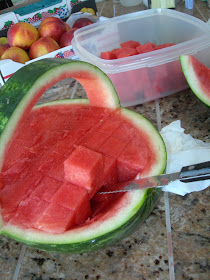 |
| Mustard greens (left) and collard greens, washed and ready to chop. |
Let's face it. Greens are not for ninnies. Most folks have no clue how to prepare them, and so gravitate to easier things, like zucchini and carrots. Yet robust greens like collards, and spicy, spiky greens like mustard, are true nutrition workhorses.
Schreiber and Sons is the only local producer of mustard greens and collards that I've found. At the next-to-last Richland farmers' market of the season, I found these gorgeous, organic greens to be on sale, but only if bought in quantity. They were $3 per bunch, but only $1 per bunch if I would buy five bunches. I hesitated only for a moment, then loaded up my cart.
I could advance so confidently because I have devised a method to make these wonderful organic greens a part of more meals, with less work. Here's the plan for frozen, on-demand greens that will amaze and satisfy.
1) Get your hands on as many bunches of fresh mustard and collard greens as you can. I used my two giant bunches of mustard greens, and two of my bunches of collard greens. (If your greens have gone limp from being in the fridge too long,
try this to revive them.)
2) Tear the collards from the stems. Wash the leaves and place in a large bowl. No need to spin dry. Run kitchen shears through the bowl, snipping to the bottom. Don't snip your fingers. In fact, keep your non-snipping hand out of the bowl, just to be safe. Alternatively, stack the leaves and slice, then chop them. Collards should be roughly chopped. Place them in a large pot.
3) Add a half inch or so of water to pot, sprinkle a little salt over all (I used 1 teaspoon of chipotle salt), and bring to a boil.
4) Cook collard greens for 15 minutes or so, adding water if necessary.
5) Meanwhile, trim the stem ends of the mustard greens, wash the greens and place them in a large bowl. You don't need to remove the mustard leaves from their stems; the stems are tender. Either chop the mustard greens with shears or make a neat pile of them and cut in strips. Reserve mustard green strips/pieces in the bowl; you're going to add them to the collards in the pot later.
6) When the collards have cooked 15 minutes, pile the chopped/sliced mustard greens into the pot on top of the collards. Sprinkle with another teaspoon of salt. Clap the lid on the pot and cook for 15 more minutes, stirring the mustard greens in as they cook down.
Soon you will have a pot of hot greens that looks like this. I stirred in a couple tablespoons of bacon grease, but that is optional; you could also use butter or olive oil.
The two white dishes in the rear of the picture are 1-1/2 quart Pyrex casseroles waiting to receive the greens for freezing. Fill your casseroles to your liking, or divide the greens into smaller containers for freezing. Evenly divide any remaining cooking liquid among the containers.
Cool, cover, refrigerate, then freeze your casseroles of greens. When frozen, run some hot water over them to loosen, then pop them into gallon-size Ziploc bags and return to the freezer.
This picture shows frozen greens prepared like this, but with prosciutto, onion and garlic added.
When you are ready to use your frozen disk of greens, get it out of the freezer and set aside for a bit. In a medium-sized skillet, saute onions and garlic in oil or fat of your choice. You may wish to use bacon or prosciutto, too. You could use sesame oil, ginger and garlic or curry paste for Oriental greens. Or go in another direction and sweeten things up with a little maple syrup or honey, and Dijon mustard. You can use cream or butter with nutmeg. Fresh or canned tomatoes are wonderful with greens. Thyme and other savory herbs go well, too. So do chopped toasted nuts, added just before serving. Your creativity is the only limit here.
When you have cooked your sauce ingredients to your liking, remove them from the skillet, then add the frozen greens with a little water and heat through until the greens are completely thawed and simmering hot. NOW pour your sauce back in over the greens, stir, and serve. Adding the sauce mixture at the last keeps bacon crispy and your sauce ingredients distinct and not overcooked.
There's nothing like dark, robust greens, with an interesting, flavorful sauce, to complement any other foods on your dinner plate. The spicy mustard greens lighten up the more sturdy collards. And you'll feel virtuous and fortified when you rise from the table!
 I washed the dill and put it to soak and revive. Topped the turnips and leeks, cleaned up the onions, seeded and peeled and chunked the banana squash. Realized I had some beets left from an earlier box, and so dinner began to take shape ... CSA Box Emergency Borscht.
I washed the dill and put it to soak and revive. Topped the turnips and leeks, cleaned up the onions, seeded and peeled and chunked the banana squash. Realized I had some beets left from an earlier box, and so dinner began to take shape ... CSA Box Emergency Borscht.
















































